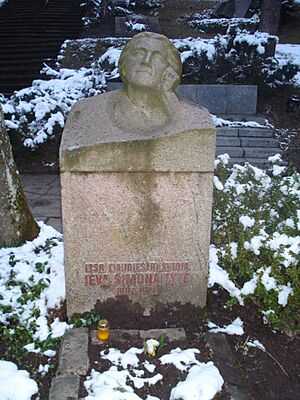Ieva Simonaitytė facts for kids
Ieva Simonaitytė (born January 23, 1897 – died August 27, 1978) was an important Lithuanian writer. She wrote about the culture of a special part of Lithuania called Lithuania Minor and the Klaipėda Region. These areas were once part of German East Prussia and had many Lithuanians living there. Simonaitytė became very famous for her novel Aukštujų Šimonių likimas (which means The Fate of Šimoniai from Aukštujai), published in 1935.
Early Life and Writing Journey
Ieva Simonaitytė was born in a small village called Vanagai. This village was in what was then German East Prussia. When she was five years old, she got sick with a bone illness called tuberculosis. Because of this, she had to use canes to walk for the rest of her life.
Ieva grew up in a poor family and didn't have a father. She started working when she was very young, looking after geese or babysitting. She learned to read and write from her mother and mostly taught herself everything else.
From 1912 to 1914, Ieva went to Angerburg for treatment for her illness. She came back feeling better. Around the time of World War I, she started writing. She published poems and short stories in Lithuanian newspapers and magazines from the Lithuania Minor region.
She worked as a seamstress until 1921. Then, she moved to Klaipėda. There, she took evening classes to learn how to be a typist and a secretary. She worked as a secretary and also translated documents.
Ieva also got involved in the politics of the Klaipėda Region. She took part in the Klaipėda Revolt in 1923, which was a time when people fought for the region to join Lithuania. She also worked for the local parliament and even spoke in court during trials against Nazis in 1934.
Becoming a Full-Time Writer
Ieva Simonaitytė's life changed in 1935 when her novel Aukštujų Šimonių likimas was published. This book was a huge success! She won a national literary award and received a special payment that allowed her to focus only on writing for the rest of her life.
In 1939, when Nazi Germany took over Klaipėda, Simonaitytė moved to Kaunas. Later, in 1963, she moved to Vilnius.
In 1961, Simonaitytė bought a summer house in Priekulė, which is close to Klaipėda. She spent most of her summers there. After she passed away, this summer house was turned into a museum in 1984, so people could learn about her life and work.
Ieva Simonaitytė died in Vilnius and was buried in a special place called the Writers' Hill in the Antakalnis Cemetery.
Exploring Simonaitytė's Novels
Ieva Simonaitytė's most famous novel, Aukštujų Šimonių likimas, tells the story of the Šimoniai family. It covers their lives from the 1700s to the 1900s. The family was once very strong and rich, but they slowly lost their power as they tried to fight against the influence of German settlers. The book shows how the family lost their wealth, their unique culture, and even their identity.
Even though the historical details in the book are mostly from her imagination, Simonaitytė included many interesting facts about old customs and traditions. She described them with great care and love. The story shows how Lithuanian culture slowly faded away under pressure from the Germans. This struggle felt sad and painful, even though it seemed unavoidable.
Another important work by Simonaitytė is Vilius Karalius (meaning Vilius King). This book came out in two parts, in 1936 and 1956. Like her famous novel, Vilius Karalius also follows the lives of several generations of Prussian Lithuanians. However, this book focuses more on the characters' feelings and how society changed around them.
Simonaitytė also wrote several books about her own life. These include:
- Be tėvo (Without a Father, 1941)
- ... O buvo taip (It Was Thus..., 1960)
- Ne ta pastogė (A Different Home, 1962)
- Nebaigta knyga (Unfinished Book, 1965)
Sometimes, in her later books, Simonaitytė used too many words or was a bit too emotional. Also, during the Soviet era, her books were sometimes changed by the government. For example, it took six years to publish her novel Pikčiurnienė because it had to be rewritten to fit the government's ideas. This book, about a woman who was very greedy, was changed to show how bad greed and cruelty were among rich people, which the Soviet government used to justify their actions.


